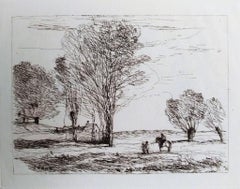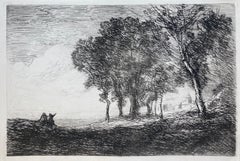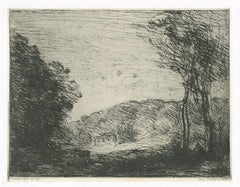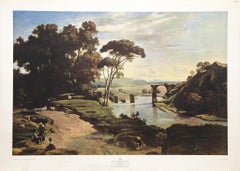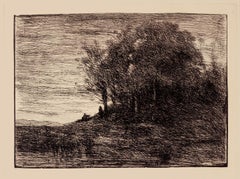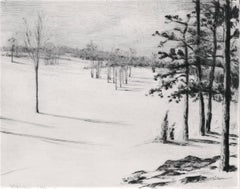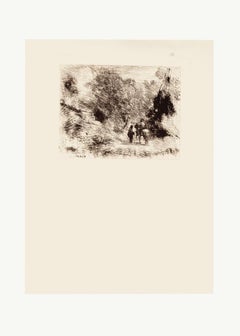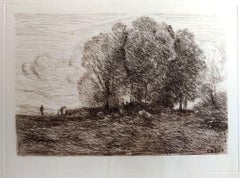Jean-Baptiste-Camille Corot Landscape Prints
French, 1796-1875
Corot was a French landscape and portrait painter as well as a printmaker who is considered a great master of landscape painting in the 19th century. A pivotal figure in landscape painting, his vast output (over 3,000 paintings) simultaneously references the Neo-Classical tradition and anticipates the plein-air innovations of Impressionism. In the spring of 1829, Corot came to Barbizon to paint in the Forest of Fontainebleau, he had first painted in the forest at Chailly in 1822. He returned to Barbizon in the autumn of 1830 and in the summer of 1831, where he made drawings and oil studies, from which he made a painting intended for the Salon of 1830. The Barbizon school of painters were part of an art movement towards Realism in art, which arose in the context of the dominant Romantic Movement of the time. The Barbizon school was active roughly from 1830 through 1870.(Biography provided by Lost Art Gallery)
to
1
5
4
5
4
7
1
1
Overall Height
to
Overall Width
to
4
6
4
1
1
1
1
1
1
1
1
7
2
13
137
135
128
113
6
1
1
1
Artist: Jean-Baptiste-Camille Corot
Landscape #4 - Etching by Camille Corot - 1850s
By Jean-Baptiste-Camille Corot
Located in Roma, IT
Landscape #4 is a beautiful original etching realized by Camille Corot in the middle of XIX Century.
Image Dimensions: 18.5 x 25.5 cm
Very good conditions.
Includes passepartout....
Category
Mid-20th Century Modern Jean-Baptiste-Camille Corot Landscape Prints
Materials
Etching
Landscape #3
By Jean-Baptiste-Camille Corot
Located in Roma, IT
Landscape is a beautiful original etching realized by Camille Corot in the middle of XIX Century. Perfect conditions, platemark is present.
It represents a natural landscape with som...
Category
1850s Modern Jean-Baptiste-Camille Corot Landscape Prints
Materials
Etching
PAYSAGE D’ ITALIE
By Jean-Baptiste-Camille Corot
Located in Santa Monica, CA
JEAN-BAPTISTE CAMILLE COROT (1876 - 1875)
PAYSAGE D’ ITALIE 1866 (Melot 7 iii/iii)
Etching, plate 6 ¼ x 9 inches, Third state after the removal of the text but before the random scr...
Category
1860s Romantic Jean-Baptiste-Camille Corot Landscape Prints
Materials
Etching
Campagne boisée (Wooded countryside)
By Jean-Baptiste-Camille Corot
Located in Middletown, NY
1866
Etching on cream wove paper. 5 1/2 x 4 3/8 inches (138 x 110 mm), full margins. Third state (of 4). Light scattered age tone, and time stain. Scattered extremely light areas of ...
Category
Mid-19th Century Barbizon School Jean-Baptiste-Camille Corot Landscape Prints
Materials
Etching
"The Bridge of Narni" by Camille Corot. Limited Edition Lithograph: TP 666
By Jean-Baptiste-Camille Corot
Located in Clinton Township, MI
Limited Edition Print of "The Bridge of Narni" by Camille Corot
Published by The Twin Editions, New York Graphic Society, 1959.
Print measures 19 in x 26.2 in. Printed in Switzerland...
Category
20th Century Jean-Baptiste-Camille Corot Landscape Prints
Materials
Lithograph
Landscape - Original Etching on Paper by Camille Corot - 19th Century
By Jean-Baptiste-Camille Corot
Located in Roma, IT
Landscape is an original etching artwork realized by Camille Corot.
With the stamp of "Collezione Contessa Laetitia Pecci-Blunt" lower right on the rear...
Category
19th Century Realist Jean-Baptiste-Camille Corot Landscape Prints
Materials
Etching
Landscape - Original Etching by Camille Corot - 19th Century
By Jean-Baptiste-Camille Corot
Located in Roma, IT
Landscape is an original print artwork realized by Camille Corot.
With the stamp of "Collezione Contessa Laetitia Pecci-Blunt" lower right on the rear.
In good condition except for diffused foxing and the trace of humidity just below the top margin.
Included a Passepartout: 49 x 34 cm. Image Dimensions: 16.5 x 23 cm
Light, and brilliant landscape with the poetical expression of trees, the work is characterized by a well-balanced lightning which created a strong feeling of the scene, with the movement of trees in the wind through intense black made shadows and light with a strong feeling of nature.
Jean-Baptiste Camille Corot...
Category
19th Century Modern Jean-Baptiste-Camille Corot Landscape Prints
Materials
Etching
SOUVENIR D'OSTIE
By Jean-Baptiste-Camille Corot
Located in Portland, ME
Corot, Jean-Baptiste-Camille. SOUVENIR D'OSTIE. Delteil 57, Melot 57. Cliche Verre, 1855. Second State of two, with the signature of Corot in reverse, low...
Category
1850s Jean-Baptiste-Camille Corot Landscape Prints
Materials
Black and White
Souvenir d’Eza
By Jean-Baptiste-Camille Corot
Located in Roma, IT
Cliché-verre.
Magnificent proof of ancient edition, numbered in red pencil on verso, and whose subject wasn’t included in the later reprints by Bouasse-Lebel and Le Garrec. Signed on...
Category
1870s Modern Jean-Baptiste-Camille Corot Landscape Prints
Materials
Plate Glass
Related Items
Under Greylock, Etching by Peter Milton
By Peter Milton
Located in Long Island City, NY
Artist: Peter Milton, American (1930 - )
Title: Under Greylock
Year: 1993
Medium: Intaglio Etching, signed and numbered in pencil
Edition: 175
Image Size: 18.25 x 15 inches
Size: 25 ...
Category
1990s American Modern Jean-Baptiste-Camille Corot Landscape Prints
Materials
Etching
Edge of the Woods.
By William Harry Warren Bicknell
Located in Storrs, CT
Edge of the Woods. 1916. Drypoint. 7 7/8 x 9 3/4 (sheet 10 7/16 x 13 1/8). A rich impression in printed on Japanese paper with an oak leaf watermark. Signed and annotated '3rd state'...
Category
Early 20th Century American Modern Jean-Baptiste-Camille Corot Landscape Prints
Materials
Drypoint, Etching
House on Cliff Walk, Newport, Rhode Island
By Clifford Isaac Addams
Located in Storrs, CT
House on Cliff Walk, Newport, R.I. 1931-1932. Etching and drypoint. Hausberg catalog 13 state .i/ii. Edition 75 in this state. 5 7/8 x 7 7/8 (sheet 9 x 13 1/2). A rich impression pr...
Category
Mid-20th Century American Modern Jean-Baptiste-Camille Corot Landscape Prints
Materials
Drypoint, Etching
New England Winter: The Old Homestead.
By Gustave Adolph Hoffman
Located in Storrs, CT
New England Winter: The Old Homestead. 1896. Etching and aquatint printed in grey-green. 7 3/4 x 11 3/4 (sheet 10 x 13 1/16). A rich impression in p...
Category
Late 19th Century American Modern Jean-Baptiste-Camille Corot Landscape Prints
Materials
Etching, Aquatint
The Fighting Temeraire: A Framed 19th C. Engraving After J. M. W. Turner
By J.M.W. Turner
Located in Alamo, CA
This beautiful 19th century framed engraving "The Fighting Temeraire" by James Tibbetts Willmore is based on an original painting by the renowned British artist J.M.W. Turner. It was published by James S. Virtue & Co. in London between 1859-1875. It depicts the once mighty British warship the HMS Temeraire being towed away down the river Thames by a much smaller steamboat to a ship-breaking yard to be broken up for scrap. The Temeraire was first launched in 1798 and represented the pinnacle of British ship-building. 180-feet long, constructed of English oak and armed with 98 guns, she was one of the largest warships of the period. The Temeraire became a symbol of British pride and military power that endured throughout the 19th century. The man-of-war served during the French Revolutionary and Napoleonic Wars and was among the last serving ships to have been at the Battle of Trafalgar in 1805. It became one of the many older ships put out of service in the 1830s and 1840s. The once mighty and feared ship symbolizes a once magnificent, but now obsolete, technology. Turner seems to lament her inglorious final journey, being towed by a less magnificent, but modern steam powered tugboat.
The Turner painting was created in 1838 and is now held in the National Gallery in London. Willmore's engraving, created in 1859, captures the dramatic scene with great detail and skill. The image has become an iconic representation of the decline of Britain's naval power and the transition from sail to steam in the 19th century. The sunset in the background is symbolic of the sun going down on British naval power and tradition. The painting conveys profound and diverse themes that are central to the human experience: those of mortality and change, technology and progress, heroism and brutality. The painting demonstrates Turner’s skill as an artist. His ability to produce scenes of great beauty that are dramatic, but are also symbolic, stimulating both thoughtful analysis, as well as emotion. Turner's painting was voted by the British public in a 2005 BBC radio sponsored survey to be the British people's favorite painting of all time. In 2020 it was included on a new British banknote...
Category
Mid-19th Century Romantic Jean-Baptiste-Camille Corot Landscape Prints
Materials
Engraving
H 18 in W 20.5 in D 1 in
Low Country (South Carolina)
By Elizabeth Verner
Located in Middletown, NY
An enchanting Southern landscape by the mother of the Charleston Renaissance.
A native of Charleston, South Carolina, and educated under the tutelage of Thomas Anshutz at The Pennsylvania Academy of Fine Arts, O'Neill Verner was a teacher, a mother, an artist, an ardent preservationist, and a skilled autodidact. Having previously focused on painting, in the early 1920s she found herself deeply moved by printmaking as a media, and especially so by the simple, peaceful themes and tableaus she discovered in Japanese art. She embarked on a effort to teach herself Japanese printmaking techniques, and in the process, produced the charming images of every day life in Charleston and its environs that earned her recognition as a cultural icon in her day, and in more modern times, as the mother of the Charleston Renaissance, which flourished well into the 1930s. In 1923 she opened a studio in Charleston where she focused on documenting the local color and the architecture and landscape that distinguishes Charleston as one of the South's most beautiful cities, all the while applying the gentle and poetic thematic sensibilities of Japanese printmaking. O'Neill Verner soon found herself in high demand when municipalities and institutions throughout the country sought commissions from her to document the beauty of their grounds and historic buildings. She worked as far north as the campuses of Harvard and Princeton, and extensively across the South, including in Savannah, Georgia, where through sweeping commissions she was able to marry her love of southern preservation and art. O'Neill Verner was a lifelong learner, and continued a path of edification that led her to study etching at the Central School of Art in London, to travel extensively through Europe, and to visit Japan in 1937, where she studied sumi (brush and ink) painting. She was a founding member of the Charleston Etchers Club, and the Southern States Art League. Her works are represented in the permanent collections of leading museums across the American south, and in major national institutions including the Metropolitan Museum of Art, Boston's Museum of Fine Art, and the Smithsonian American Art Museum. O'Neil Verner...
Category
Early 20th Century American Modern Jean-Baptiste-Camille Corot Landscape Prints
Materials
Archival Paper, Drypoint, Etching
Comanche Dance, Ildefonso Pueblo, New Mexico Southwest Framed Etching
By Gene Kloss
Located in Denver, CO
Comanche Dance at San Ildefonso Pueblo (New Mexico). Etching and drypoint, artist's proof from an edition of 50 prints. Presented in a custom frame, outer dimensions measure 22 ¼ x 18 ½ x ½ inches. Image size is 11 ¾ x 14 ½ inches.
Print is clean and in very good vintage condition - please contact us for a detailed condition report.
Expedited and international shipping is available - please contact us for a quote.
About the Artist:
Gene (Alice Geneva) Kloss is considered one of America’s master printmakers. She was born in Oakland, California and established herself as an artist on the West coast.
Kloss was introduced to etching by Perham Nahl while at UC Berkley. She graduated in 1924, and in 1925 married poet Phillips Kloss. In her late twenties, Kloss moved to Taos, New Mexico and began her life’s work of the New Mexican landscape and peoples. It was at this time that she received national acclaim.
Her artwork exudes an unmistakable content and style. Enchanted by the architecture, mountainous landscapes and rituals of the inhabitants, Kloss captured the beauty of the Southwest and surrounding areas. Her style was bold yet deftly simple, masterfully expressing the elusive Southwestern light...
Category
1980s American Modern Jean-Baptiste-Camille Corot Landscape Prints
Materials
Drypoint, Etching
H 22.25 in W 18.5 in D 0.5 in
Salvador Dalí, "Les lauriers du bonheur" original etching, hand colored, signed
By Salvador Dalí
Located in Chatsworth, CA
Salvador Dalí
Les lauriers du bonheur (The laurels of happiness) from After 50 Years of Surrealism
Original etching with hand coloring, h...
Category
1970s Modern Jean-Baptiste-Camille Corot Landscape Prints
Materials
Etching
Ulysses Deriding Polyphemus: A Framed 19th C. Engraving After J. M. W. Turner
By J.M.W. Turner
Located in Alamo, CA
This beautiful 19th century framed hand-colored engraving/etching entitled "Ullyses Deriding Polyphemus" by Edward Goodall is based on an original 1829 painting by the renowned Briti...
Category
Mid-19th Century Romantic Jean-Baptiste-Camille Corot Landscape Prints
Materials
Engraving, Etching
H 13.88 in W 17.25 in D 1.5 in
A View of Scarborough, England: A Framed 19th C. Engraving After J. M. W. Turner
By J.M.W. Turner
Located in Alamo, CA
This beautiful 19th century framed engraving "Scarborough" by W. Chapman is based on an original painting by the renowned British artist J.M.W. Turner. It was published in London by ...
Category
Mid-19th Century Romantic Jean-Baptiste-Camille Corot Landscape Prints
Materials
Engraving
H 18.25 in W 20.88 in D 1 in
19th century color lithograph figures cemetery willow tree memorial headstone
By Nathaniel Currier
Located in Milwaukee, WI
The present hand-colored lithograph was produced as part of the funeral and mourning culture in the United States during the 19th century. Images like this were popular as ways of remembering loved ones, an alternative to portraiture of the deceased. This lithograph shows a man, woman and child in morning clothes next to an urn-topped stone monument. Behind are additional putto-topped headstones beneath weeping willows, with a steepled church beyond. The monument contains a space where a family could inscribe the name and death dates of a deceased loved one. In this case, it has been inscribed to a young Civil War soldier:
William W. Peabody
Died at Fairfax Seminary, VA
December 18th, 1864
Aged 18 years
The young Mr. Peabody probably died in service for the Union during the American Civil War. Farifax Seminary was a Union hospital and military headquarters in Alexandria, Virginia. The hospital served nearly two thousand soldiers during the war time. Five hundred were also buried on the Seminary's grounds.
13.75 x 9.5 inches, artwork
23 x 19 inches, frame
Published before 1864
Inscribed bottom center "Lith. & Pub. by N. Currier. 2 Spruce St. N.Y."
Framed to conservation standards using 100 percent rag matting and TruVue Conservation Clear glass, housed in a gold gilded moulding.
Nathaniel Currier was a tall introspective man with a melancholy nature. He could captivate people with his piercing stare or charm them with his sparkling blue eyes. Nathaniel was born in Roxbury, Massachusetts on March 27th, 1813, the second of four children. His parents, Nathaniel and Hannah Currier, were distant cousins who lived a humble yet spartan life. When Nathaniel was eight years old, tragedy struck. Nathaniel’s father unexpectedly passed away leaving Nathaniel and his eleven-year-old brother Lorenzo to provide for the family. In addition to their mother, Nathaniel and Lorenzo had to care for six-year-old sister Elizabeth and two-year-old brother Charles. Nathaniel worked a series of odd jobs to support the family, and at fifteen, he started what would become a life-long career when he apprenticed in the Boston lithography shop of William and John Pendleton.
A Bavarian gentleman named Alois Senefelder invented lithography just 30 years prior to young Nat Currier’s apprenticeship. While under the employ of the brothers Pendleton, Nat was taught the art of lithography by the firm’s chief printer, a French national named Dubois, who brought the lithography trade to America.
Lithography involves grinding a piece of limestone flat and smooth then drawing in mirror image on the stone with a special grease pencil. After the image is completed, the stone is etched with a solution of aqua fortis leaving the greased areas in slight relief. Water is then used to wet the stone and greased-ink is rolled onto the raised areas. Since grease and water do not mix, the greased-ink is repelled by the moisture on the stone and clings to the original grease pencil lines. The stone is then placed in a press and used as a printing block to impart black on white images to paper.
In 1833, now twenty-years old and an accomplished lithographer, Nat Currier left Boston and moved to Philadelphia to do contract work for M.E.D. Brown, a noted engraver and printer. With the promise of good money, Currier hired on to help Brown prepare lithographic stones of scientific images for the American Journal of Sciences and Arts. When Nat completed the contract work in 1834, he traveled to New York City to work once again for his mentor John Pendleton, who was now operating his own shop located at 137 Broadway. Soon after the reunion, Pendleton expressed an interest in returning to Boston and offered to sell his print shop to Currier. Young Nat did not have the financial resources to buy the shop, but being the resourceful type he found another local printer by the name of Stodart. Together they bought Pendleton’s business.
The firm ‘Currier & Stodart’ specialized in "job" printing. They produced many different types of printed items, most notably music manuscripts for local publishers. By 1835, Stodart was frustrated that the business was not making enough money and he ended the partnership, taking his investment with him. With little more than some lithographic stones, and a talent for his trade, twenty-two year old Nat Currier set up shop in a temporary office at 1 Wall Street in New York City. He named his new enterprise ‘N. Currier, Lithographer’
Nathaniel continued as a job printer and duplicated everything from music sheets to architectural plans. He experimented with portraits, disaster scenes and memorial prints, and any thing that he could sell to the public from tables in front of his shop. During 1835 he produced a disaster print Ruins of the Planter's Hotel, New Orleans, which fell at two O’clock on the Morning of the 15th of May 1835, burying 50 persons, 40 of whom Escaped with their Lives. The public had a thirst for newsworthy events, and newspapers of the day did not include pictures. By producing this print, Nat gave the public a new way to “see” the news. The print sold reasonably well, an important fact that was not lost on Currier.
Nat met and married Eliza Farnsworth in 1840. He also produced a print that same year titled Awful Conflagration of the Steamboat Lexington in Long Island Sound on Monday Evening, January 18, 1840, by which melancholy occurrence over One Hundred Persons Perished. This print sold out very quickly, and Currier was approached by an enterprising publication who contracted him to print a single sheet addition of their paper, the New York Sun. This single page paper is presumed to be the first illustrated newspaper ever published.
The success of the Lexington print launched his career nationally and put him in a position to finally lift his family up. In 1841, Nat and Eliza had their first child, a son they named Edward West Currier. That same year Nat hired his twenty-one year old brother Charles and taught him the lithography trade, he also hired his artistically inclined brother Lorenzo to travel out west and make sketches of the new frontier as material for future prints. Charles worked for the firm on and off over the years, and invented a new type of lithographic crayon which he patented and named the Crayola. Lorenzo continued selling sketches to Nat for the next few years.
In 1843, Nat and Eliza had a daughter, Eliza West Currier, but tragedy struck in early 1847 when their young daughter died from a prolonged illness. Nat and Eliza were grief stricken, and Eliza, driven by despair, gave up on life and passed away just four months after her daughter’s death.
The subject of Nat Currier’s artwork changed following the death of his wife and daughter, and he produced many memorial prints and sentimental prints during the late 1840s. The memorial prints generally depicted grief stricken families posed by gravestones (the stones were left blank so the purchasers could fill in the names of the dearly departed). The sentimental prints usually depicted idealized portraits of women and children, titled with popular Christian names of the day.
Late in 1847, Nat Currier married Lura Ormsbee, a friend of the family. Lura was a self-sufficient woman, and she immediately set out to help Nat raise six-year-old Edward and get their house in order. In 1849, Lura delivered a son, Walter Black Currier, but fate dealt them a blow when young Walter died one year later. While Nat and Lura were grieving the loss of their new son, word came from San Francisco that Nat’s brother Lorenzo had also passed away from a brief illness. Nat sank deeper into his natural quiet melancholy. Friends stopped by to console the couple, and Lura began to set an extra place at their table for these unexpected guests. She continued this tradition throughout their lives.
In 1852, Charles introduced a friend, James Merritt Ives, to Nat and suggested he hire him as a bookkeeper. Jim Ives was a native New Yorker born in 1824 and raised on the grounds of Bellevue Hospital where his father was employed as superintendent. Jim was a self-trained artist and professional bookkeeper. He was also a plump and jovial man, presenting the exact opposite image of his new boss.
Jim Ives met Charles Currier through Caroline Clark, the object of Jim’s affection. Caroline’s sister Elizabeth was married to Charles, and Caroline was a close friend of the Currier family. Jim eventually proposed marriage to Caroline and solicited an introduction to Nat Currier, through Charles, in hopes of securing a more stable income to support his future wife.
Ives quickly set out to improve and modernize his new employer’s bookkeeping methods. He reorganized the firm’s sizable inventory, and used his artistic skills to streamline the firm’s production methods. By 1857, Nathaniel had become so dependent on Jims’ skills and initiative that he offered him a full partnership in the firm and appointed him general manager. The two men chose the name ‘Currier & Ives’ for the new partnership, and became close friends.
Currier & Ives produced their prints in a building at 33 Spruce Street where they occupied the third, fourth and fifth floors. The third floor was devoted to the hand operated printing presses that were built by Nat's cousin, Cyrus Currier, at his shop Cyrus Currier & Sons in Newark, NJ. The fourth floor found the artists, lithographers and the stone grinders at work. The fifth floor housed the coloring department, and was one of the earliest production lines in the country. The colorists were generally immigrant girls, mostly German, who came to America with some formal artistic training. Each colorist was responsible for adding a single color to a print. As a colorist finished applying their color, the print was passed down the line to the next colorist to add their color. The colorists worked from a master print displayed above their table, which showed where the proper colors were to be placed. At the end of the table was a touch up artist who checked the prints for quality, touching-in areas that may have been missed as it passed down the line. During the Civil War, demand for prints became so great that coloring stencils were developed to speed up production.
Although most Currier & Ives prints were colored in house, some were sent out to contract artists. The rate Currier & Ives paid these artists for coloring work was one dollar per one hundred small folios (a penny a print) and one dollar per one dozen large folios. Currier & Ives also offered uncolored prints to dealers, with instructions (included on the price list) on how to 'prepare the prints for coloring.' In addition, schools could order uncolored prints from the firm’s catalogue to use in their painting classes.
Nathaniel Currier and James Merritt Ives attracted a wide circle of friends during their years in business. Some of their more famous acquaintances included Horace Greeley, Phineas T. Barnum, and the outspoken abolitionists Rev. Henry Ward, and John Greenleaf Whittier (the latter being a cousin of Mr. Currier).
Nat Currier and Jim Ives described their business as "Publishers of Cheap and Popular Pictures" and produced many categories of prints. These included Disaster Scenes, Sentimental Images, Sports, Humor, Hunting Scenes, Politics, Religion, City and Rural Scenes, Trains, Ships, Fire Fighters, Famous Race Horses, Historical Portraits, and just about any other topic that satisfied the general public's taste. In all, the firm produced in excess of 7500 different titles, totaling over one million prints produced from 1835 to 1907.
Nat Currier retired in 1880, and signed over his share of the firm to his son Edward. Nat died eight years later at his summer home 'Lion’s Gate' in Amesbury, Massachusetts. Jim Ives remained active in the firm until his death in 1895, when his share of the firm passed to his eldest son, Chauncey.
In 1902, faced will failing health from the ravages of Tuberculosis, Edward Currier sold his share of the firm to Chauncey Ives...
Category
Mid-19th Century Romantic Jean-Baptiste-Camille Corot Landscape Prints
Materials
Watercolor, Lithograph
LE VERT GALANT Lithograph, Abstract Cityscape Garden, Architecture, Trees
By (after) Pablo Picasso
Located in Union City, NJ
Artist: Pablo Picasso, After, Spanish (1881 - 1973)
Title: LE VERT GALANT # 21-B
Year of Original Artwork: 1943
Edition of 1000, unnumbered, estate approved printed signature
Print size - 21.5 x 29.5
Published - 1979-1982
Pablo Picasso's - LE VERT GALANT is a limited edition lithograph re-created after an original painting from the estate Collection of Marina Picasso, Picasso's grand-daughter. Printed using hand drawn lithographic plates(not a photo reproduction or digital print) on archival heavy weight Coventry printmaking paper, 100% acid free. Edition was produced in accordance with the Picasso family...
Category
1980s Abstract Jean-Baptiste-Camille Corot Landscape Prints
Materials
Lithograph
Previously Available Items
Landscape - Original Etching by Camille Corot - 19th Century
By Jean-Baptiste-Camille Corot
Located in Roma, IT
Landscape is an original print artwork realized by Camille Corot.
Plate signed.
In good condition.
Included a Passepartout: 49 x 34
Light, and brilli...
Category
19th Century Naturalistic Jean-Baptiste-Camille Corot Landscape Prints
Materials
Etching
H 5.52 in W 7.29 in D 0.04 in
Landscape #4 - Etching by Camille Corot - 1850s
By Jean-Baptiste-Camille Corot
Located in Roma, IT
Landscape #4 is a beautiful original etching realized by Camille Corot in the middle of XIX Century.
Image Dimensions: 18.5 x 25.5 cm
Very good condit...
Category
Mid-20th Century Modern Jean-Baptiste-Camille Corot Landscape Prints
Materials
Etching
H 16.54 in W 12.21 in D 0.04 in
La Porte d'Arras - Etching by Camille Corot - 1870
By Jean-Baptiste-Camille Corot
Located in Roma, IT
La porte d'Arras is a beautiful original etching realized by Camille Corot in 1870.
Very good conditions. Signed on the lower right margin of the plate...
Category
1870s Jean-Baptiste-Camille Corot Landscape Prints
Materials
Etching
H 6.7 in W 5.63 in D 0.04 in
Landscape - Original Etching By Camille Corot - Late 19th Century
By Jean-Baptiste-Camille Corot
Located in Roma, IT
Image dimensions: 10 x 15 cm.
Landscape is an original print artwork realized by Camille Corot. With the stamp of "Collezione Contessa Laetitia Pecci-Bl...
Category
Late 19th Century Modern Jean-Baptiste-Camille Corot Landscape Prints
Materials
Etching
H 16.54 in W 12.21 in D 0.04 in
Landscape - Original Etching By Camille Corot - Late 19th Century
By Jean-Baptiste-Camille Corot
Located in Roma, IT
Landscape is an original etching, realized by Camille Corot (1796-1875). with the stamp" Collection Contessa Anna Laetitia Pecci-Bblunt" on the lower lef...
Category
Late 19th Century Modern Jean-Baptiste-Camille Corot Landscape Prints
Materials
Etching
H 16.54 in W 12.01 in D 0.04 in
Landscape #4 - Original Etching by Camille Corot - 1850
By Jean-Baptiste-Camille Corot
Located in Roma, IT
Landscape #4 is a beautiful original etching realized by Camille Corot in the middle of XIX Century. Very good conditions except for a halo on the lower...
Category
1850s Modern Jean-Baptiste-Camille Corot Landscape Prints
Materials
Etching
H 16.54 in W 12.21 in D 0.04 in
Souvenir de Fampoux
By Jean-Baptiste-Camille Corot
Located in Roma, IT
Cliché-verre.
Fine proof of the ancient edition, in brown. Minor removals on the subject, which wasn’t included in the later reprints by Bouasse-Lebel and Le Garrec. Monogram on plat...
Category
1850s Modern Jean-Baptiste-Camille Corot Landscape Prints
Materials
Plate Glass
Souvenir d'Italie
By Jean-Baptiste-Camille Corot
Located in Roma, IT
Fine etching by Camille Corot, a French landscape painter and printmaker in etching.Original Prints.
Image Dimensions : 28.5 x 21.5 cm
This artwork is shipped from Italy. Under exis...
Category
Mid-19th Century Realist Jean-Baptiste-Camille Corot Landscape Prints
Materials
Etching
L'Etang a Ville d'Array (The Pond in Ville d'Array) /// Barbizon Corot Landscape
By Jean-Baptiste-Camille Corot
Located in Saint Augustine, FL
Artist: (after) Jean-Baptiste Camille Corot (French, 1796-1875)
Title: "L'Etang a Ville d'Array (The Pond in Ville d'Array)"
Portfolio: Cent Chefs d'Oeuvre (Hundred Masterpieces of Work)
*Issued unsigned, though signed by Giroux in the plate (printed signature) lower right
Year: 1883
Medium: Original Etching on laid paper
Limited edition: 600
Printer: Unknown, Paris?, France
Publisher: Unknown, Paris?, France
Framing: Framed in a silver Baroque style moulding with a 8-ply silver silk mat
Framed size: 16.25" x 19"
Image size: 6" x 10"
Condition: Some light cosmetic wear to frame. In excellent condition
Notes:
This etching is after a painting of the same title by French artist Jean-Baptiste Camille Corot (1796-1875). Engraved by French artist Charles Giroux (1828-1885). This etching was exhibited at the "Cent Chefs d'Oeuvre" or "Hundred Masterpieces of Work", an exhibition held June 12, 1883 in the Gallery of Georges Petit, Paris, France. Georges Petit (1856-1920) was a French art dealer, a key figure in the Paris art world and an important promoter and cultivator of Impressionist artists.
Biography:
Jean-Baptiste-Camille Corot (July 17, 1796 - February 22, 1875) was a French landscape painter and printmaker in etching. Corot was the leading painter of the Barbizon school of France in the mid-nineteenth century. He is a pivotal figure in landscape painting and his vast output simultaneously references the Neo-Classical tradition and anticipates the plein-air innovations of Impressionism.
Camille Corot was born in Paris in 1796, in a house at 125 Rue du Bac, now demolished. His family were bourgeois people-his father was a wigmaker and his mother a milliner-and unlike the experience of some of his artistic colleagues, throughout his life he never felt the want of money, as his parents made good...
Category
1880s Barbizon School Jean-Baptiste-Camille Corot Landscape Prints
Materials
Etching, Intaglio, Laid Paper
Garda Lake
By Jean-Baptiste-Camille Corot
Located in Saint Augustine, FL
An original etching on laid paper by French artist Charles Henri Toussaint (1849-1911) after French artist Jean-Baptiste Camille Corot's (1796-1875) painting titled "Garda Lake", 188...
Category
1880s Impressionist Jean-Baptiste-Camille Corot Landscape Prints
Materials
Etching, Laid Paper
Mantes La Jolie
By Jean-Baptiste-Camille Corot
Located in Saint Augustine, FL
An original etching by French artist Jean-Baptiste-Camille Corot (1796-1875) titled "Mantes La Jolie", 1883. Engraved by Henri Emile LeFort. Limited Edition of 600. This etching was ...
Category
Late 19th Century Barbizon School Jean-Baptiste-Camille Corot Landscape Prints
Materials
Etching
Jean-baptiste-camille Corot landscape prints for sale on 1stDibs.
Find a wide variety of authentic Jean-Baptiste-Camille Corot landscape prints available for sale on 1stDibs. You can also browse by medium to find art by Jean-Baptiste-Camille Corot in etching, glass, laid paper and more. Much of the original work by this artist or collective was created during the 19th century and is mostly associated with the modern style. Not every interior allows for large Jean-Baptiste-Camille Corot landscape prints, so small editions measuring 5 inches across are available. Customers who are interested in this artist might also find the work of Albert Marquet, Utagawa Hiroshige, and Marcel Mouly. Jean-Baptiste-Camille Corot landscape prints prices can differ depending upon medium, time period and other attributes. On 1stDibs, the price for these items starts at $175 and tops out at $3,750, while the average work can sell for $649.

